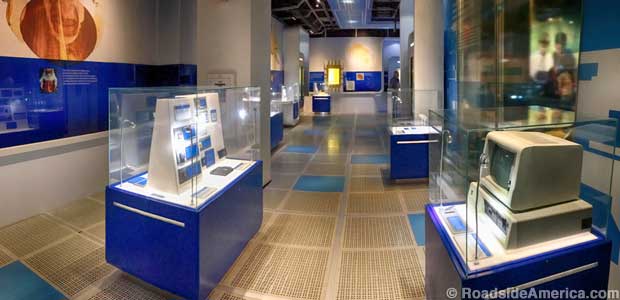
Intel Museum
Santa Clara, California
Tech companies aren't known for presenting human faces. Sure, there are a handful of hoodie visionaries and car-in-orbit CEOs, but engineer-driven corporations want to solve problems, not use up precious face time with the public. As a result, there's often no Barnum to usher everyone inside the tent, no Edison to electrocute the elephant.
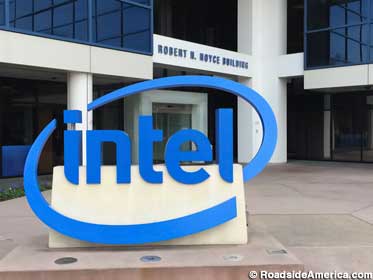
Take Intel, a wildly successful corporation that became the world's largest manufacturer of silicon chips. Intel is an "ingredient" brand -- one of the first marketed to consumers -- an essential part of computers by companies such as Microsoft and Apple. The "Intel Inside" sonic logo chime triggered familiarity with the brand and trust of whatever was going on inside.
In 2018, the public heard more about those insides than they wanted to: every computer and phone with an Intel chip made since 1995 may have a hack-vulnerable design flaw. There was a scramble to issue patches and plug holes. Some reports warned about serious, long-lasting effects.
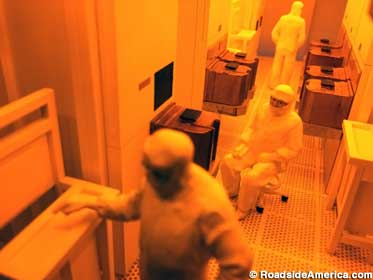
Model of silicon chip fabrication plant.
But who to blame? Whose face belongs on the perp meme?
The Intel Museum in Silicon Valley offers no answers, but it is the place to learn more about the company, its founders, its history, and the history of semiconductor chips and microprocessors, the basic hardware building blocks of computers. The free, 10,000-square-foot exhibit at Intel corporate headquarters in Santa Clara is an essential Silicon Valley stop for any computer geek pilgrimage. Museum maps are available in Mandarin, English, French, German, Japanese, Korean, and Spanish. Anyone can pose with the big logo in the entrance plaza.
The museum is all blue and white plastic and metal. Floor panels are labeled with relevant elements from the periodic table. Circuit boards and silicon chips are everywhere, under glass, balanced and mounted like the reliquary bones of saints. This is a sanctuary of engineering and applied science.
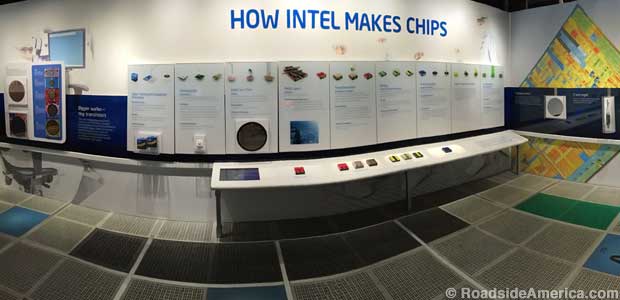
Robert Noyce and Gordon Moore formed the company, no parents' garage involved. They'd been in the nascent Silicon Valley since 1956, first working for Shockley Semiconductor Laboratory, run by the brilliant but irritating William Shockley (co-inventor of the transistor at Bell Labs) before fleeing with a group of fed up colleagues, later dubbed "The Traitorous Eight," to form Fairchild Semiconductor. In 1968, Moore and Noyce left Fairchild and founded their own company (Intel, truncating "Integrated Electronics").
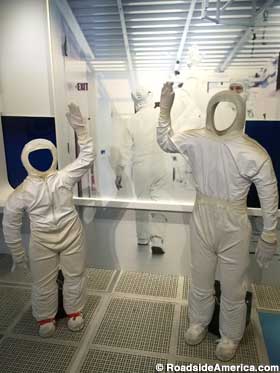
You Are There, in an Intel Clean Room.
Bob Noyce, who died in 1990, was nicknamed the "Mayor of Silicon Valley" for his role in the region's explosive growth. Intel's early breakthrough invention was the integrated circuit, which Noyce claimed in interviews "came out of my own laziness" from having to ship multiple piece parts to customers to assemble. The innovation was to pre-assemble many transistors on a single silicon wafer. By the time Intel was producing Pentium processors, each one delivered the processing power of 3.1 million transistors. In 2007, a Core processor chip contained 50 quadrillion transistors.
You might know Gordon Moore as the author of the computer industry's famous "Moore's Law," a bit of predictive wisdom about the pace in which computer technology advances. In 1965 he worked out how computers would likely double in processing power each year, while costs plummeted. (Maybe he wrote another law about how a dropped bagel always lands on the cream cheese side, but the museum only enshrines his law about computers.) As of this writing, Gordon Moore is still alive, and deservedly rich.
"Journey Through Decades of Innovation" tells about significant innovations in the company's history. Example: The Intel 1702 EPROM. "In 1971, Intel pioneered the world's first EPROM, a nonvolatile Erasable Programmable Read Only Memory." Intel engineer Don Frohman was trying to solve an entirely different problem when he discovered that ultraviolet light could erase a chip and allow it to be reprogrammed. In the late 1980s flash memory became a pursuit, and the EPROMs were sidelined in the mid-1990s as Flash minicards provided storage for digital cameras and audio recorders.
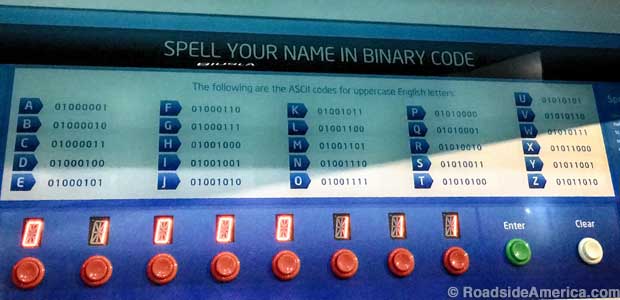
Attempt to write your name in binary code.
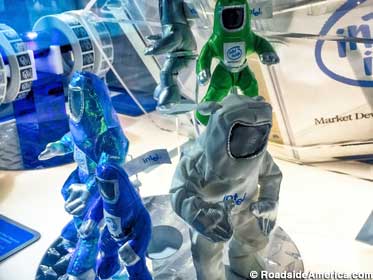
The BunnyPeople of 1997.
"How Intel Makes Chips" walks visitors through the key fabrication steps, such as Etching, Photolithography, Metal Deposition, and the Wafer Sort Test. It sounds complicated, and somewhat dull as a daily job -- but on the plus side, employees wear full body "clean room" garments -- called bunny suits. Models and scenes of clean room facilities show the dustless, antiseptic environments critical to producing perfect chips. After countless movies and games where sealed facilities of scientists in coveralls unleash contamination Hell, it's nice to see that sterile room protocols mostly work.
In the 1990s, the "Intel Inside" advertising campaign started to solder the company into the collective unconscious, making it one of the most well known computer brands. In 1997, Intel's marketing introduced the BunnyPeople (tm) dancers -- humanoid creatures in clean room suits -- during the Superbowl. The display at the museum notes that the BunnyPeople "became cultural icons."
The museum is probably most meaningful to members of the industry, who appreciate the context. But everything is described for the average person, perhaps someone too scared to turn on their unpatched computer or phone.
A rigid pair of clean room suits invite visitors to pose and stick their heads through the hood holes. You're the face of Intel!





